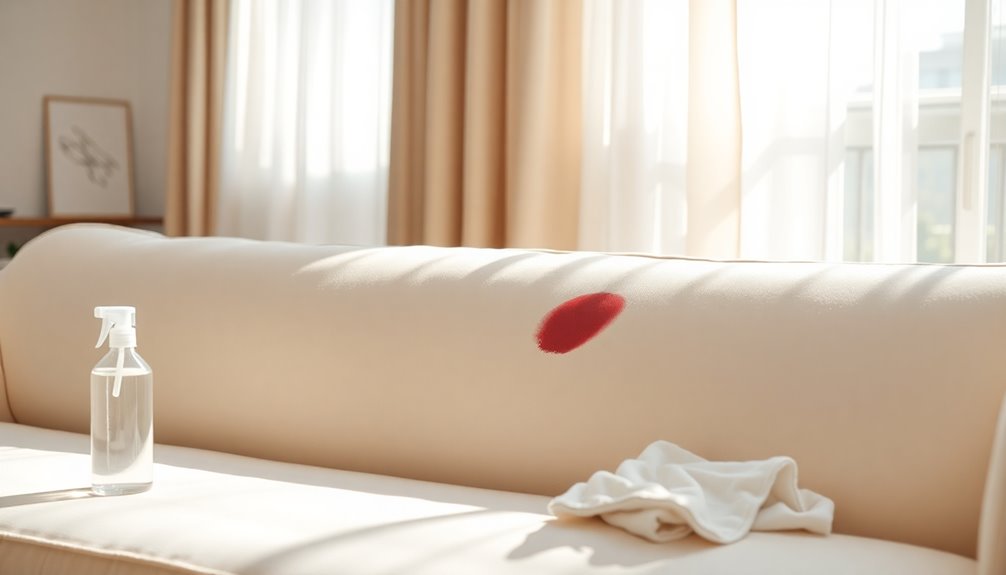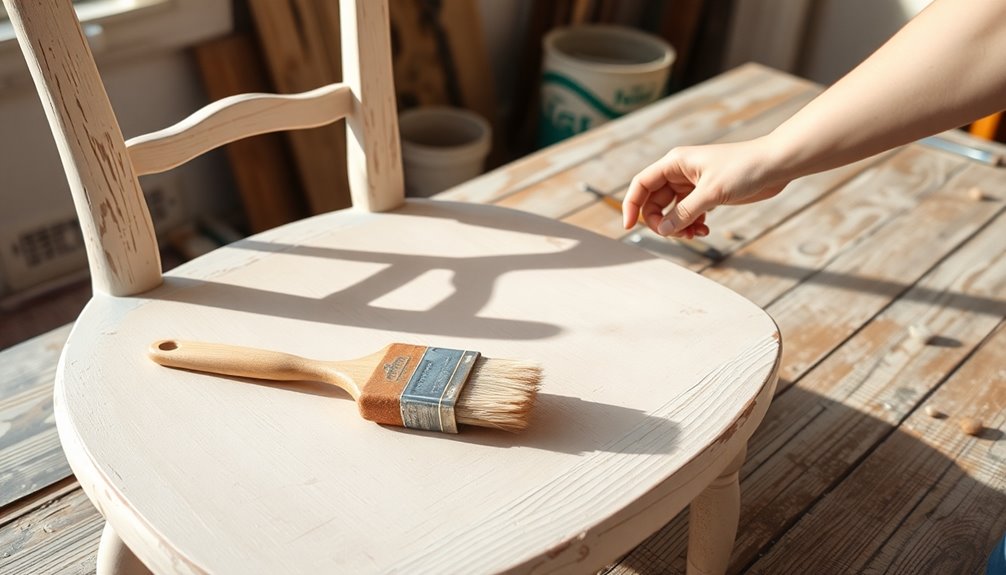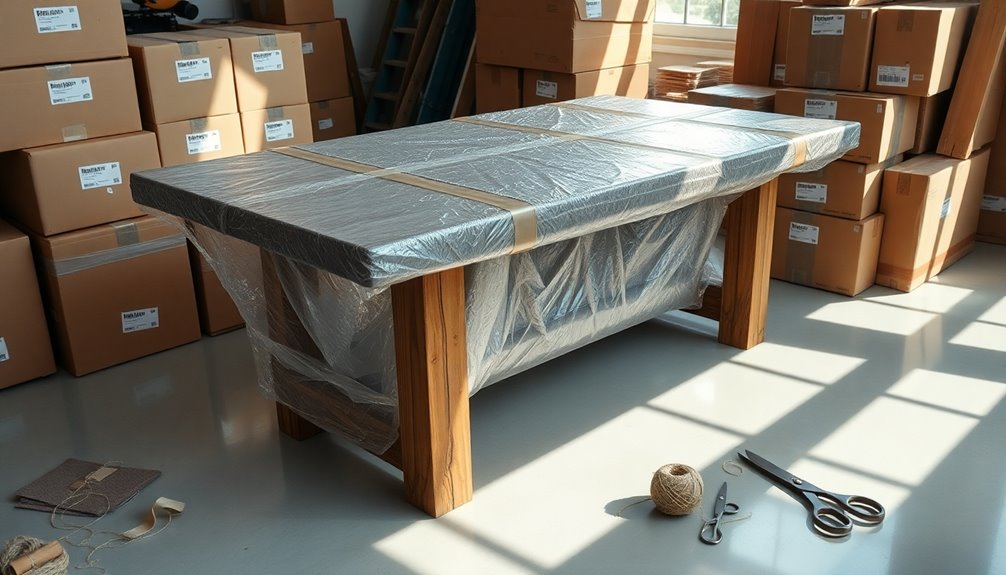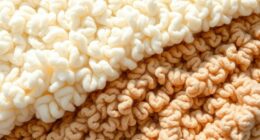To remove blood from your sofa, act fast to prevent the stain from setting. Start by gently blotting the area with a clean cloth and cold water; never rub, as that can spread the stain. Mix cold water with a bit of soap or use an enzyme-based cleaner. Apply this solution directly to the stain and scrub gently with a soft brush or cloth. Rinse thoroughly with cold water. If the stain persists, try hydrogen peroxide or a baking soda paste. With these tips, you can tackle stubborn stains effectively and keep your sofa looking great, so keep exploring for more insights.
Key Takeaways
- Act quickly to blot fresh blood stains with a clean cloth, avoiding rubbing to prevent spreading.
- Use cold water to blot the stain, as hot water can set the blood.
- Mix soap with cold water or use an enzyme-based cleaner to break down blood proteins.
- For stubborn stains, apply hydrogen peroxide or a saltwater solution, then rinse with cold water.
- Allow the area to air dry completely to prevent mold growth after cleaning.
Introduction
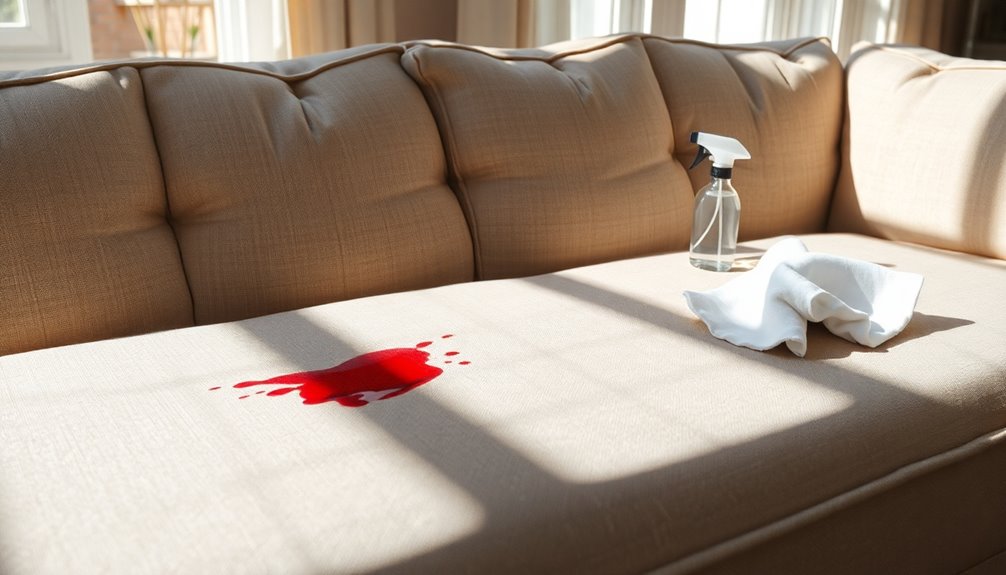
When it comes to keeping your sofa looking great, routine upholstery care is key. Knowing the right cleaning techniques for different materials will help you tackle tough stains, especially blood. In this guide, you'll learn effective methods to remove blood stains while preserving your sofa's fabric.
Routine Upholstery Care
Routine upholstery care is essential for keeping your furniture looking great and lasting longer. Regular cleaning and maintenance can significantly prolong the lifespan of your upholstery while preventing the buildup of dirt and stains. Start by vacuuming your furniture with a soft brush attachment at least once a week. This helps remove dust and debris, minimizing the risk of stains setting in.
When spills happen, don't wait! Spot clean them immediately with appropriate cleaning solutions tailored for your upholstery type. Quick action can prevent stains from becoming more difficult to remove. Additionally, consider applying a fabric protector. This creates a barrier against stains and spills, making your routine cleaning efforts even more effective.
While daily and weekly care is vital, don't forget the importance of periodic professional cleaning. This deep cleaning method can help tackle tough stains and ensure the integrity and appearance of your upholstery are maintained. By incorporating these routine care practices, you'll keep your furniture looking fresh and inviting for years to come, making it easier to handle any unexpected stains that may arise.
Material-Specific Cleaning Techniques
Cleaning blood stains from upholstery can be a challenge, but understanding the specific material of your furniture makes a significant difference. Different fabrics require tailored approaches to effectively remove blood without causing damage. For cotton and polyester, mix cold water with a few drops of dish detergent as your cleaning solution. Gently blot the stain with a cloth soaked in this mixture, ensuring you don't rub, which could spread the blood.
If your sofa is leather, treat it carefully. Use a damp cloth to wipe away the blood, then follow up with a specialized leather cleaner. This helps prevent water damage and maintains the material's integrity.
For delicate fabrics labeled "Dry Clean Only," it's best to avoid home attempts. Instead, take them to a professional cleaner who can safely handle the stain.
Regardless of the fabric, always perform a spot test with any cleaning solution on an inconspicuous area first. This ensures that the cleaner won't harm or discolor your upholstery. Taking these material-specific steps can save your furniture and keep it looking its best.
Blood Stain Removal Techniques
Understanding the right techniques for blood stain removal can make all the difference in preserving your sofa's appearance. Prompt treatment is essential; fresh blood stains are significantly easier to remove than dried ones, which can set into the fabric. Start by using cold water to blot the stain, as hot water can cause the proteins in the blood to coagulate, making the stain harder to clean.
For an effective cleaning solution, mix soap and cold water. Gently dab the stained area with a clean cloth instead of rubbing, which can spread the blood further. If you’re dealing with stubborn stains that won’t budge, try using hydrogen peroxide or enzyme-based cleaners. Just remember to test these on a small, inconspicuous area of your sofa first to avoid damaging the fabric. To remove stains from sofa effectively, ensure you act quickly, as fresh stains are always easier to treat. Once you’ve applied your chosen solution, blot the area gently until the stain begins to lift, and then rinse with a clean, damp cloth to remove any residue. Finally, allow the fabric to air dry completely before using the sofa again to prevent any moisture from setting in.
Regular maintenance and immediate treatment of stains can prolong your upholstery's life, significantly reducing the likelihood of permanent stains. By following these techniques, you'll enhance your chances of keeping your sofa looking its best, even in the face of blood stains.
Sofa Protection With Slipcovers
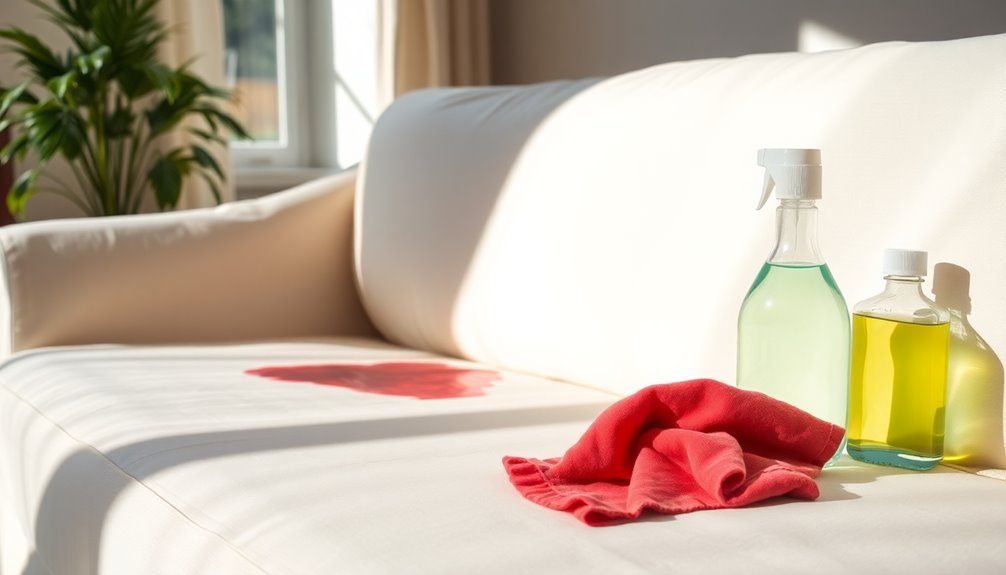
Slipcovers are your best bet for keeping your sofa safe from stains and spills. By choosing durable, stain-resistant fabrics, you create protective layers that extend the lifespan of your furniture. Plus, they're easy to wash, so you can maintain a fresh look without hassle. Additionally, incorporating natural materials like wood and stone in your living space can enhance the overall farmhouse aesthetic.
Durable, Stain-Resistant Fabrics
When it comes to protecting your sofa from spills and stains, opting for durable, stain-resistant fabrics is a smart choice. Microfibers and synthetic blends are designed to repel liquids and resist staining, making them perfect for homes with high traffic. These durable fabrics help prevent dried blood stains and other messes from setting in, giving you peace of mind.
You can enhance your sofa's protection by using slipcovers made from treated materials. These slipcovers not only offer an extra layer of defense against spills but also allow for easy washing and maintenance. If you choose fabrics with a high rub count, typically over 15,000, you'll find they withstand daily wear and tear much better than lower-rated options.
Consider applying stain-resistant treatments like Teflon or Scotchgard to your upholstery. These create a protective barrier that makes removing blood and other stains much easier. Regular cleaning and maintenance of both slipcovers and upholstery will prolong the life of the fabric and maintain its stain-resistant properties, ensuring your sofa stays looking great for years to come.
Protective Fabric Layers
Adding protective fabric layers to your sofa is a practical step toward maintaining its appearance and longevity. Slipcovers act as a barrier that effectively shields your sofa from stains, including blood, and they're easy to remove for washing. Choosing high-quality slipcovers made from materials like cotton, polyester, or linen can enhance both the durability and aesthetic appeal of your furniture.
When you opt for machine-washable slipcovers, you make cleaning and maintenance a breeze. Any spills or stains can be promptly addressed, ensuring that your sofa stays looking fresh and clean. Regularly washing your slipcovers not only helps keep stains out of fabric but also prolongs the life of the underlying sofa material.
Investing in high-quality slipcovers means you're protecting your sofa against everyday wear and tear while also adding a stylish touch to your living space. With the right care, your slipcovers can maintain their appearance and functionality, making them a smart choice for anyone looking to safeguard their furniture. Additionally, incorporating mindful decluttering practices can further enhance your living environment by reducing distractions and promoting a sense of calm. Remember, the right protective fabric layers can make all the difference in keeping your sofa looking brand new!
Extending Fabric Lifespan
How can you ensure your sofa remains in top condition for years to come? One of the best strategies is to invest in slipcovers. These protective barriers help prevent spills and stains from directly contacting the upholstery fabric, significantly extending your sofa's lifespan. If you ever face a situation where you need to remove blood stains, slipcovers can be a lifesaver.
Regularly washing your slipcovers keeps them fresh and hygienic. Most machine-washable options withstand multiple washes without fading or shrinking, so you won't have to worry about their quality over time. Plus, choosing slipcovers made from stain-resistant fabrics can make cleanup even easier, allowing you to tackle any liquid spills with a simple wet cloth. Additionally, integrating smart home devices can help monitor your home's environment, ensuring optimal conditions that further protect your furniture.
This approach not only protects your investment but also saves you from costly reupholstering or hiring cleaning services. With a range of colors and patterns available, you can easily update your sofa's look while ensuring it's shielded from everyday wear and tear. By incorporating slipcovers into your home, you're not just protecting your furniture; you're extending its life and maintaining its beauty for years to come.
Upholstery Stitching and Seams

When you're dealing with blood stains, the integrity of your upholstery stitching and seams matters more than you might think. Weak or frayed seams can trap stains, leading to bigger cleaning challenges down the line. By ensuring your upholstery is well-maintained and considering reupholstering for enhanced durability, you can keep your seating cozy and inviting while minimizing future stain issues.
Fabric Integrity Concerns
Moisture and harsh cleaning agents can significantly weaken the stitching and seams of upholstery, which is crucial to consider when tackling blood stains. When you attempt to remove the blood, the fabric integrity is at stake. If you don't act quickly, the blood stains can compromise the fibers, leading to fraying or unraveling. Different materials react differently; for example, natural fibers like cotton may be more vulnerable to damage than synthetic fibers like polyester.
To protect your upholstery, avoid excessive scrubbing around the seams, as this can stress the stitching and create small tears. Instead, use gentle blotting techniques and mild cleaning solutions that won't harm the fabric. Always check the care label for specific cleaning instructions related to your upholstery type.
Regular maintenance and prompt stain treatment not only enhance the appearance of your sofa but also help preserve its structural integrity. By being mindful of how you handle blood stains, you can ensure that the stitching and seams remain intact over time, prolonging the life of your furniture. Remember, a little care goes a long way in keeping your upholstery looking its best.
Reupholstering for Enhanced Durability
Reupholstering your sofa not only revitalizes its appearance but also significantly enhances its durability, ensuring that it withstands the rigors of daily use. By selecting high-quality commercial fabric, you can extend the life of your furniture and protect it from wear and tear. Look for materials with higher rub counts, as these fabrics resist fading and fraying, making them ideal for busy households.
Proper upholstery stitching techniques are crucial for durability. Using double stitching or reinforced seams strengthens the fabric, allowing it to endure everyday use more effectively. Additionally, consider utilizing fade-resistant and stain-repellent treatments during the reupholstering process. This way, if a spill occurs, you can often clean the area easily, and once the stain is removed, the fabric maintains its fresh appearance. Furthermore, investing in trusted custodians can provide you with peace of mind and enhance the value of your home furnishings.
Regular maintenance is key to preserving your newly upholstered sofa. Make it a habit to inspect and tighten loose seams, as this will help prevent further damage. With these steps, your reupholstered sofa will not only look great but also provide you with long-lasting comfort and style.
Cozy, Inviting Seating Experience
Creating a cozy, inviting seating experience starts with the details of upholstery stitching and seams. The quality of stitching significantly impacts your sofa's durability and integrity, ensuring it stands the test of time. High-quality upholstery often features double-stitched seams, which not only enhance strength but also give a polished look.
You might notice different sewing techniques, like topstitching and welted seams, reinforcing areas prone to wear and tear. Regularly inspect these stitching details to catch any signs of wear early. If you spot an affected area, prompt repairs can prevent further damage and maintain your sofa's inviting nature.
Choosing the right thread type, such as polyester or nylon, is crucial too. These materials resist fading, keeping colors vibrant even in high-traffic areas. If stains occur, like blood, remember a gentle cleaner can help, but be cautious not to disrupt the stitching. Taking care of your upholstery means more than just cleaning; it's about maintaining the craftsmanship that creates a warm and welcoming environment in your home. Prioritize these details, and you'll enjoy a comfortable, stylish seating experience for years to come. Additionally, using a HEPA filter in your cleaning routine can help reduce allergens and improve the air quality in your home while you maintain your upholstery.
Personalized Fabric Treatments
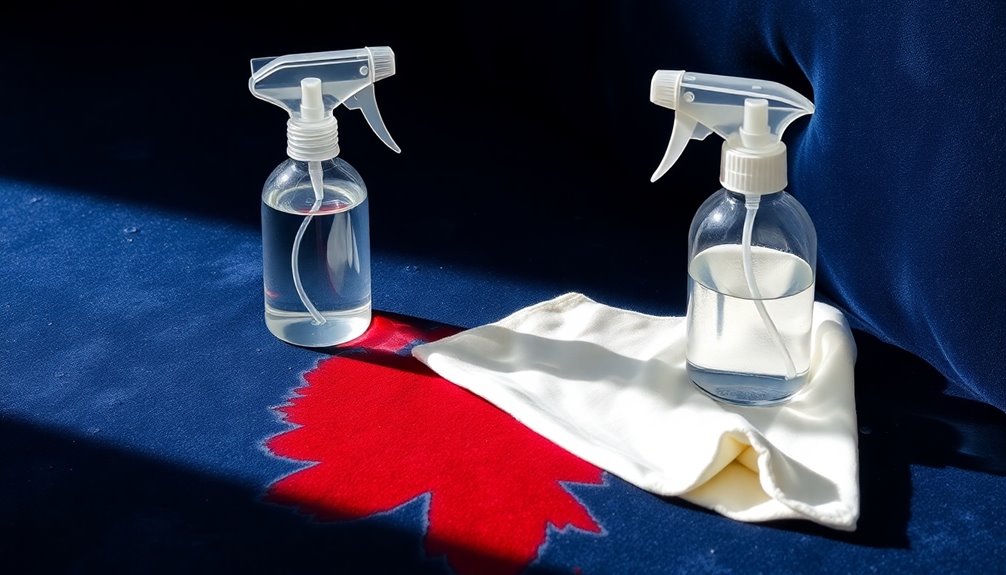
When it comes to personalized fabric treatments for blood stains on your sofa, knowing your upholstery type is essential. Always check the care label, as different types of fabric require specific cleaning methods—like W, S, SW, or X. If your fabric allows water-based cleaning, mix 80% cold water with 10% glycerin and 10% laundry detergent. This solution effectively lifts blood stains without damaging the material.
For delicate fabrics, you should choose enzyme-based cleaners designed for organic stains. These specialized stain removers can penetrate and break down blood proteins without harming your upholstery. If you have synthetic materials, a simple mixture of dish detergent and cold water works well. Make sure to dab the stained area gently, blotting rather than scrubbing to avoid damage.
Before applying any cleaning solution, always perform a spot test on an inconspicuous area of the fabric. This precaution ensures that the treatment won't cause discoloration or additional damage. By customizing your approach based on your sofa's fabric, you can effectively tackle blood stains while preserving its beauty and integrity.
Stain-Resistant Fabric Options
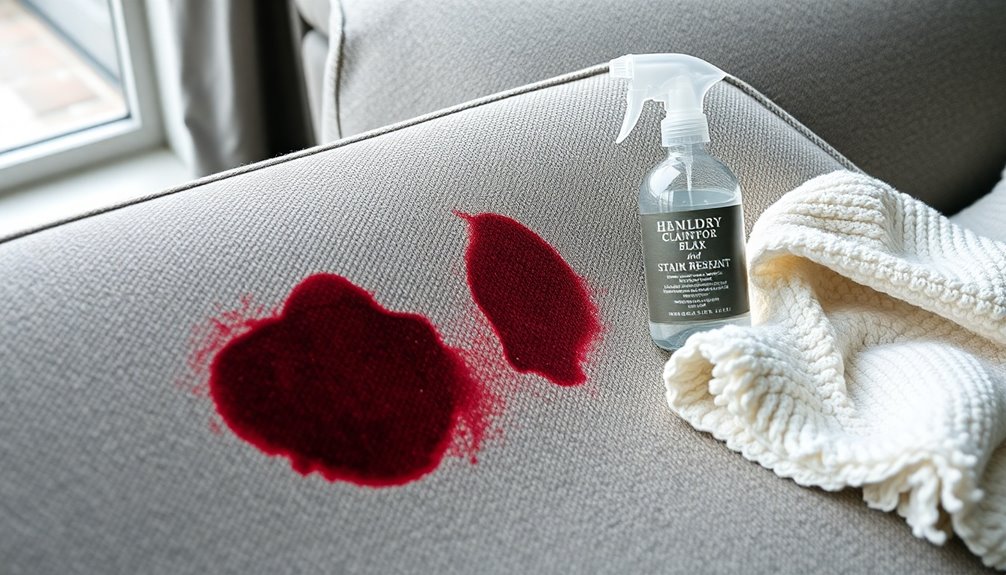
If you want to simplify your cleaning routine, consider investing in stain-resistant fabric options for your sofa. Stain-resistant fabrics, like treated polyester and acrylic, are designed to repel liquids and resist staining, making them easier to clean. Microfiber is another popular choice due to its tightly woven fibers that prevent spills from penetrating the fabric. If you prefer leather, ensure it's properly treated with protective coatings; this not only adds durability but also allows for easy cleanup of spills.
For high-traffic areas, look into performance fabrics like Crypton and Sunbrella, which are engineered to be water-resistant and stain-repellent. These options can help keep your sofa looking cleaner on your couch, even with regular use. However, remember that regular maintenance is key. Applying fabric protectors and promptly addressing spills will enhance the effectiveness of your stain-resistant fabrics. If you act quickly when a spill occurs, you can often prevent permanent stains, ensuring your sofa remains in great condition for years to come.
Conclusion
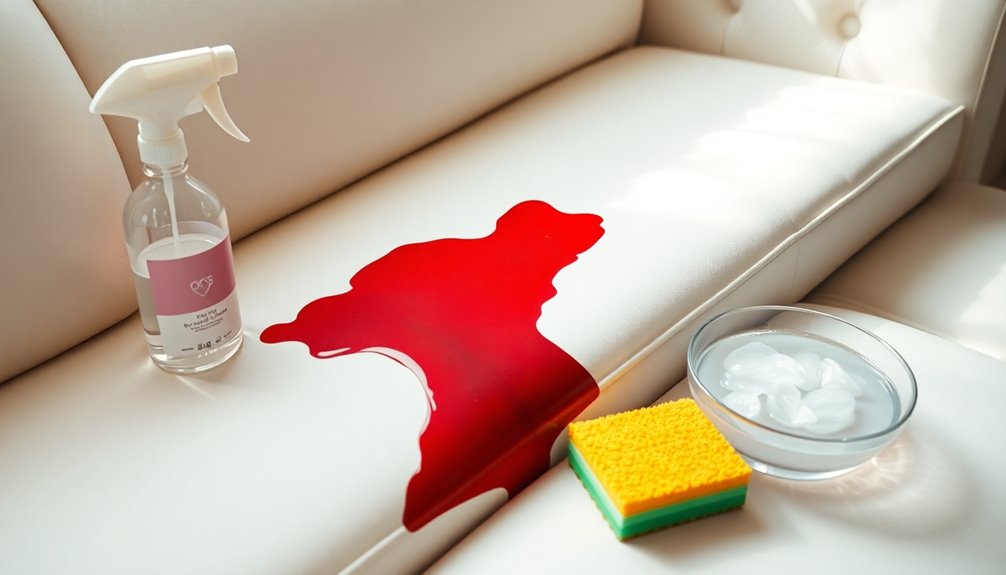
In summary, addressing blood stains on your sofa quickly is essential to preserving its appearance and longevity. Fresh stains are much easier to remove than dried ones, so don't hesitate to act immediately. Always use cold water when cleaning blood stains, as hot water can set the stain, making it harder to eliminate.
Before applying any cleaner, test it on a hidden area of the fabric to prevent damage or discoloration. If the stain proves stubborn, consider using enzyme-based cleaners or hydrogen peroxide, ensuring you rinse thoroughly afterward to avoid any residue. Regular maintenance and prompt action can significantly extend your sofa's life and help you avoid permanent staining.
Frequently Asked Questions
How Do You Get Dried Blood Out of a Couch?
To tackle dried blood stains, start by gently loosening the stain with a soft-bristled toothbrush. Dab the area with a dry cloth to lift any flakes. Next, dampen a white cloth with cold water or rubbing alcohol and gently dab the stain, avoiding any rubbing. If needed, mix a tablespoon of dish detergent with two cups of cold water, applying it to the stain, and let it sit for about 30 minutes before blotting it away.
How Do You Get Dried Blood Out of Fabric?
To get dried blood out of fabric, start by gently scraping off any residue with a soft-bristled toothbrush. Then, soak a clean cloth in cold water or rubbing alcohol, dabbing at the stain without rubbing it. For tougher stains, mix 80% cold water, 10% liquid laundry detergent, and 10% glycerin, applying the solution and letting it sit for 30 minutes. Blot with a damp cloth, rinse with cold water, and repeat if necessary.
How Do You Get Blood Out of Fabric Seats?
To get blood out of fabric seats, start by blotting the stain with a clean, damp cloth and cold water. For fresh stains, mix cold water with dish detergent and gently dab the area until the stain lifts. For dried blood, use a soft-bristled toothbrush to loosen it before cleaning. If necessary, apply hydrogen peroxide, let it bubble, then blot and rinse. Always check the care label before applying any cleaners.
Does Dawn Dish Soap Remove Blood Stains?
Yes, Dawn dish soap can effectively remove blood stains. You'll want to mix a tablespoon of Dawn with two cups of cold water. Gently dab the solution onto the stain with a clean cloth, making sure not to scrub, as that can damage the fabric. After you've treated the stain, rinse the area with cold water to eliminate any soap residue. Just remember, avoid hot water to prevent setting the stain.
